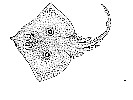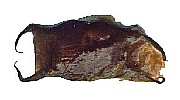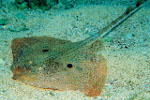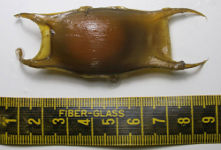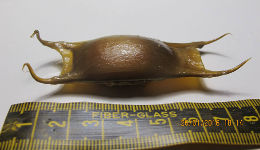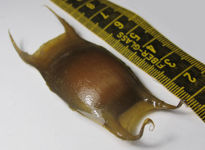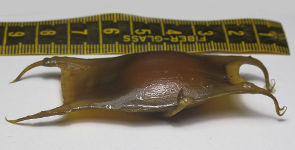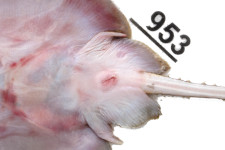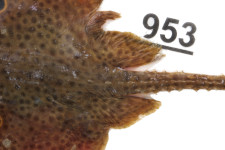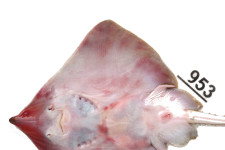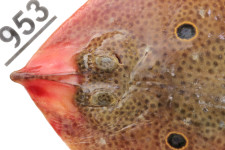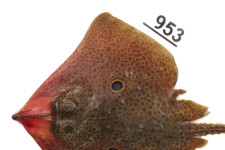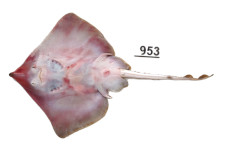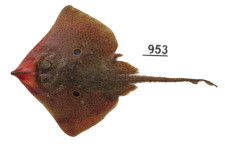Raja miraletus
Linnaeus, 1758
Brown ray
Classification: Elasmobranchii Rajiformes Rajidae
Reference of the original description
Systema Naturae per regna tria naturae, regnum animale, secundum classes, ordines, genera, species, cum characteribus differentiis synonymis, locis. Tomus I. Editio decima, reformata. Stockholm, Laurentii Salvii, 824pp.
Systema Naturae per regna tria naturae, regnum animale, secundum classes, ordines, genera, species, cum characteribus differentiis synonymis, locis. Tomus I. Editio decima, reformata. Stockholm, Laurentii Salvii, 824pp.
Image of the original description
No image in first description.
No image in first description.
Synonyms / new combinations and misspellings
Raia miraletus, Raia quadrimaculata, Raja cf. miraletus, Raja quadrimaculata, Raja (Raja) miraletus
Raia miraletus, Raia quadrimaculata, Raja cf. miraletus, Raja quadrimaculata, Raja (Raja) miraletus
Description :
Citation: Raja miraletus Linnaeus, 1758: In: Database of modern sharks, rays and chimaeras, www.shark-references.com, World Wide Web electronic publication, Version 01/2026
Please send your images of "Raja miraletus" to info@shark-references.com
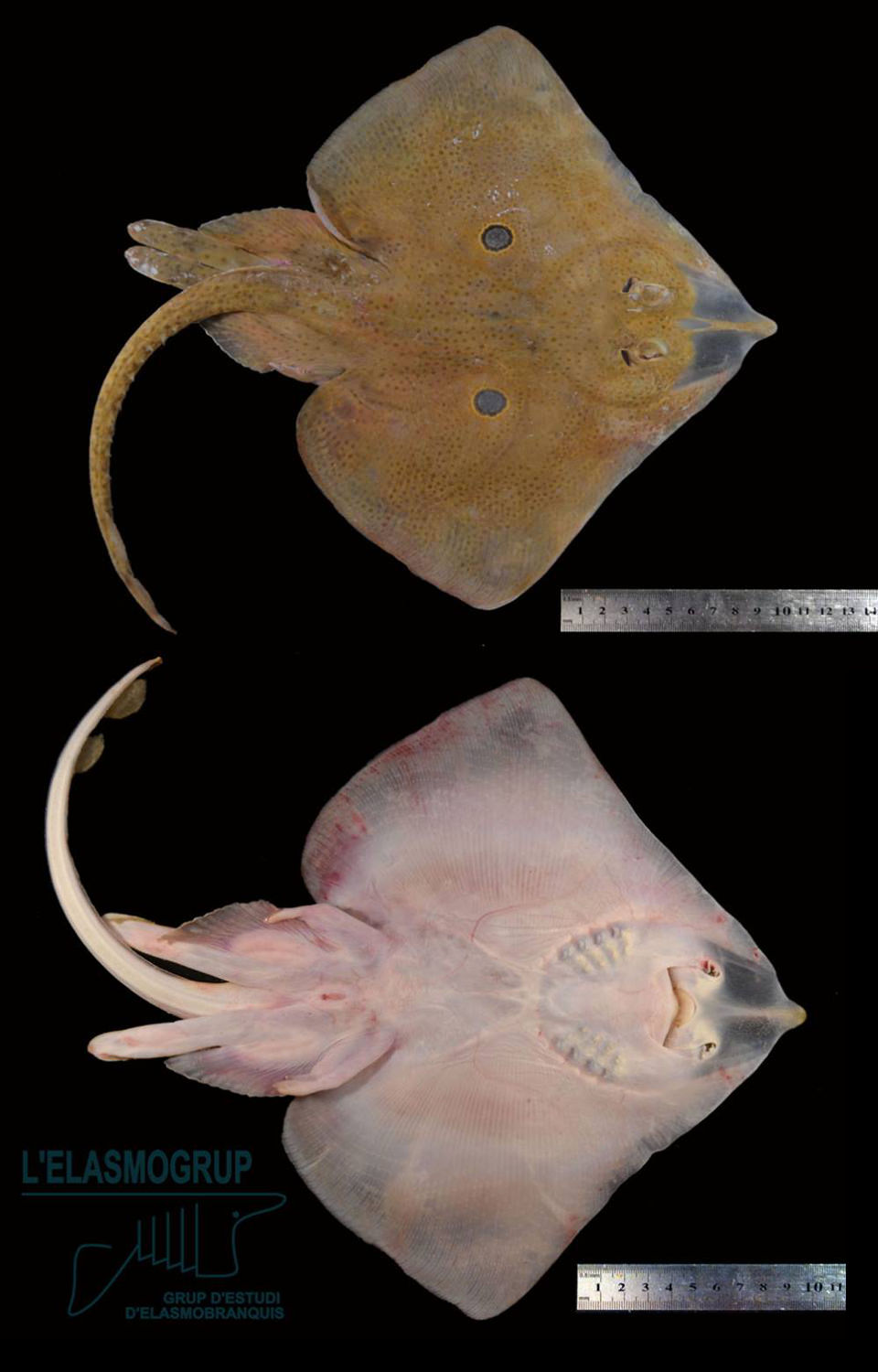
Raja miraletus Linnaeus, 1758, off port of Valencia © L'Elasmogrup, University of Valencia)

Raja miraletus Linnaeus, 1758, off port of Valencia © L'Elasmogrup, University of Valencia)
Common names
 Braunrochen,
Braunrochen,  Pfauenaugen-Rochen,
Pfauenaugen-Rochen,  Rochen,
Rochen,  Spiegelrochen,
Spiegelrochen,  Vieraugen-Rochen,
Vieraugen-Rochen,  Vieräagiger Spiegelrochen,
Vieräagiger Spiegelrochen,  Vieräugiger Spiegelrochen,
Vieräugiger Spiegelrochen,  Zweifleckiger Rochen,
Zweifleckiger Rochen,  Bachada escrita,
Bachada escrita,  Clavellada,
Clavellada,  Excrita,
Excrita,  Grisol,
Grisol,  Racho de escrita,
Racho de escrita,  Raja de espejos,
Raja de espejos,  Rajada de San Pere,
Rajada de San Pere,  Rajada limpia,
Rajada limpia,  Ratjada,
Ratjada,  Raya de espejos,
Raya de espejos,  Raya espejuelo,
Raya espejuelo,  Raya limpia,
Raya limpia,  Raya vera,
Raya vera,  Retjada,
Retjada,  Ikara,
Ikara,  Pélouza,
Pélouza,  Raie,
Raie,  Raie florifère,
Raie florifère,  Raie miraillée,
Raie miraillée,  Raie miroir,
Raie miroir,  Raie zéro,
Raie zéro,  Zerra,
Zerra,  Brown ray,
Brown ray,  Brown skate,
Brown skate,  Homelyn cuckoo ray,
Homelyn cuckoo ray,  Homelyn mirror ray,
Homelyn mirror ray,  Homelyn sandy ray,
Homelyn sandy ray,  Skate,
Skate,  Twineye ray,
Twineye ray,  Twineye skate,
Twineye skate,  Arzilla,
Arzilla,  Cchjaline,
Cchjaline,  Cchjalune,
Cchjalune,  Chiamida,
Chiamida,  Occhialina,
Occhialina,  Picara liscia,
Picara liscia,  Picara quattrocchi,
Picara quattrocchi,  Picara quattuocchi,
Picara quattuocchi,  Pichira fimminedda,
Pichira fimminedda,  Pichira liscia,
Pichira liscia,  Quatrochi,
Quatrochi,  Quatroci,
Quatroci,  Quattrocchi,
Quattrocchi,  Quattrucchi,
Quattrucchi,  Quattuecchi,
Quattuecchi,  Raja liscia,
Raja liscia,  Raja occhialuta,
Raja occhialuta,  Raja quattrocchi,
Raja quattrocchi,  Rasa quatroci,
Rasa quatroci,  Rasa sfeuggoena,
Rasa sfeuggoena,  Rascia liscia,
Rascia liscia,  Razza argentina,
Razza argentina,  Razza occhiuta,
Razza occhiuta,  Razza quattrocchi,
Razza quattrocchi,  Razza stellina,
Razza stellina,  Scritta a quattrogus,
Scritta a quattrogus,  Tappacunnu,
Tappacunnu,  Peixe-areia,
Peixe-areia,  Raia-azul,
Raia-azul,  Raia-de-dos-olhos,
Raia-de-dos-olhos,  Raia-de-espelhos,
Raia-de-espelhos,  Raia-de-quatro-olhos
Raia-de-quatro-olhos
 Braunrochen,
Braunrochen,  Pfauenaugen-Rochen,
Pfauenaugen-Rochen,  Rochen,
Rochen,  Spiegelrochen,
Spiegelrochen,  Vieraugen-Rochen,
Vieraugen-Rochen,  Vieräagiger Spiegelrochen,
Vieräagiger Spiegelrochen,  Vieräugiger Spiegelrochen,
Vieräugiger Spiegelrochen,  Zweifleckiger Rochen,
Zweifleckiger Rochen,  Bachada escrita,
Bachada escrita,  Clavellada,
Clavellada,  Excrita,
Excrita,  Grisol,
Grisol,  Racho de escrita,
Racho de escrita,  Raja de espejos,
Raja de espejos,  Rajada de San Pere,
Rajada de San Pere,  Rajada limpia,
Rajada limpia,  Ratjada,
Ratjada,  Raya de espejos,
Raya de espejos,  Raya espejuelo,
Raya espejuelo,  Raya limpia,
Raya limpia,  Raya vera,
Raya vera,  Retjada,
Retjada,  Ikara,
Ikara,  Pélouza,
Pélouza,  Raie,
Raie,  Raie florifère,
Raie florifère,  Raie miraillée,
Raie miraillée,  Raie miroir,
Raie miroir,  Raie zéro,
Raie zéro,  Zerra,
Zerra,  Brown ray,
Brown ray,  Brown skate,
Brown skate,  Homelyn cuckoo ray,
Homelyn cuckoo ray,  Homelyn mirror ray,
Homelyn mirror ray,  Homelyn sandy ray,
Homelyn sandy ray,  Skate,
Skate,  Twineye ray,
Twineye ray,  Twineye skate,
Twineye skate,  Arzilla,
Arzilla,  Cchjaline,
Cchjaline,  Cchjalune,
Cchjalune,  Chiamida,
Chiamida,  Occhialina,
Occhialina,  Picara liscia,
Picara liscia,  Picara quattrocchi,
Picara quattrocchi,  Picara quattuocchi,
Picara quattuocchi,  Pichira fimminedda,
Pichira fimminedda,  Pichira liscia,
Pichira liscia,  Quatrochi,
Quatrochi,  Quatroci,
Quatroci,  Quattrocchi,
Quattrocchi,  Quattrucchi,
Quattrucchi,  Quattuecchi,
Quattuecchi,  Raja liscia,
Raja liscia,  Raja occhialuta,
Raja occhialuta,  Raja quattrocchi,
Raja quattrocchi,  Rasa quatroci,
Rasa quatroci,  Rasa sfeuggoena,
Rasa sfeuggoena,  Rascia liscia,
Rascia liscia,  Razza argentina,
Razza argentina,  Razza occhiuta,
Razza occhiuta,  Razza quattrocchi,
Razza quattrocchi,  Razza stellina,
Razza stellina,  Scritta a quattrogus,
Scritta a quattrogus,  Tappacunnu,
Tappacunnu,  Peixe-areia,
Peixe-areia,  Raia-azul,
Raia-azul,  Raia-de-dos-olhos,
Raia-de-dos-olhos,  Raia-de-espelhos,
Raia-de-espelhos,  Raia-de-quatro-olhos
Raia-de-quatro-olhos
Short Description
Snout short and bluntly pointed; disc angular [536]. Upper surface prickly only in young, nearly smooth in adults, underside smooth [7182]. Upper surface ochre to reddish-brown with scattered dark spots, underside white [7182]; two bright blue eyespots centered on the pectoral bases [536]; may have a small dark spot on tip of snout [20085]. Diet: eastern central Adriatic Sea (data base: of 418 stomachs examined, total length (TL) of 13.5 - 40.0 cm, 38 were empty (9.0%): The prey items identified in the stomachs belong to six major groups: Decapoda (Natantia and Reptantia), Mysidacea, Teleostei, Cephalopoda, Amphipoda and Polychaeta. Decapods were the most important prey (%IRI 88.2), whereas other prey groups were only occasionally ingested. [17732] Sardinian waters (centralwestern Mediterranean) (data base: 78 specimens) In R. miraletus, Crustacea represented the main prey in all size groups (% IRI599.5, 99.6, and 88, respectively). Amphipoda Gammaridea were the predominant prey for small individuals, and were replaced in medium and large specimens by decapods. Low levels of interspecific competition were generally found.[17740]
Snout short and bluntly pointed; disc angular [536]. Upper surface prickly only in young, nearly smooth in adults, underside smooth [7182]. Upper surface ochre to reddish-brown with scattered dark spots, underside white [7182]; two bright blue eyespots centered on the pectoral bases [536]; may have a small dark spot on tip of snout [20085]. Diet: eastern central Adriatic Sea (data base: of 418 stomachs examined, total length (TL) of 13.5 - 40.0 cm, 38 were empty (9.0%): The prey items identified in the stomachs belong to six major groups: Decapoda (Natantia and Reptantia), Mysidacea, Teleostei, Cephalopoda, Amphipoda and Polychaeta. Decapods were the most important prey (%IRI 88.2), whereas other prey groups were only occasionally ingested. [17732] Sardinian waters (centralwestern Mediterranean) (data base: 78 specimens) In R. miraletus, Crustacea represented the main prey in all size groups (% IRI599.5, 99.6, and 88, respectively). Amphipoda Gammaridea were the predominant prey for small individuals, and were replaced in medium and large specimens by decapods. Low levels of interspecific competition were generally found.[17740]
Distribution
Eastern Atlantic: northern Portugal and throughout the Mediterranean to Madeira and South Africa. Reported from the Canary Islands [7182] but occurrence needs verification [17687]. Also in southwestern part of the Indian Ocean. Source: www.gbif.org
Eastern Atlantic: northern Portugal and throughout the Mediterranean to Madeira and South Africa. Reported from the Canary Islands [7182] but occurrence needs verification [17687]. Also in southwestern part of the Indian Ocean. Source: www.gbif.org
Human uses
fisheries: commercial; gamefish: yes
fisheries: commercial; gamefish: yes
Biology
Oviparous, paired eggs are laid. Embryos feed solely on yolk [733]. With egg-cases laid from spring to summer [7182]. Distinct pairing with embrace. Young may tend to follow large objects, such as their mother [17086]. Found over soft bottoms of the shelf and the uppermost slope [536]. Depth range from 17-300 m, and up to depth of 462 m in the eastern Ionian Sea [17735]. Feeds on fish, squids, benthic organisms, all kinds of benthic animals and fish offal [536].
Oviparous, paired eggs are laid. Embryos feed solely on yolk [733]. With egg-cases laid from spring to summer [7182]. Distinct pairing with embrace. Young may tend to follow large objects, such as their mother [17086]. Found over soft bottoms of the shelf and the uppermost slope [536]. Depth range from 17-300 m, and up to depth of 462 m in the eastern Ionian Sea [17735]. Feeds on fish, squids, benthic organisms, all kinds of benthic animals and fish offal [536].
Remarks
shark-references Species-ID=5707;
shark-references Species-ID=5707;
Parasites (arranged by Jürgen Pollerspöck)
Kinetoplastea
Conoidasida
Myxosporea
Monogenea
Cestoda
Isopoda
Hirudinea
Kinetoplastea
Conoidasida
- Eimeria kayarensis Diouf & Toguebaye, 1994 [17870] [15715] [32027]
- Eimeria ottojiroveci Dyková & Lom, 1983 [32027]
Myxosporea
Monogenea
- Calicotyle kroyeri Diesing, 1850 [31118]
- Empruthotrema raiae (Maccallum, 1916) Johnston & Tiegs, 1922 [31118]
- Rajonchocotyle sp. [31118]
Cestoda
- Echinobothrium affine Diesing, 1863 [16430]
- Echinobothrium mercedesae Caira, Rodriguez & Pickering, 2013 [19843]
- Echinobothrium sp. [19536]
- Echinobothrium yiae Caira, Rodriguez & Pickering, 2013 [19843] [27172]
- Grillotia erinaceus (Van Beneden, 1858) [16112] [7411]
- Parachristianella duadecacantha Palm, 2004 [16112]
Isopoda
- Anilocra frontalis H. Milne Edwards, 1830 [25069]
- Ceratothoa capri (Trilles, 1964) [25069]
- Ceratothoa collaris (Schioedte & Meinert, 1883) [23898] [19912]
Hirudinea








.jpg)
